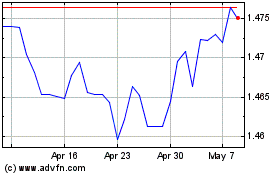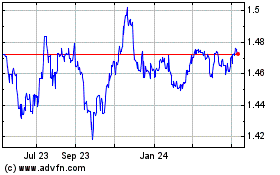Euro Climbs As Italy's Economy Minister Dismisses Euro Exit
June 11 2018 - 2:28AM
RTTF2
The euro advanced against its major opponents in the European
session on Monday, after Italian Economy Minister Giovanni Tria
said that the new government has no plans to leave the euro and is
seeking to boost growth through investment and structural reforms
instead of deficit spending.
"The position of the government is clear and unanimous. There is
no question of leaving the euro," Tria said to Italian newspaper
Corriere della Sera on Sunday.
"The government is determined to prevent in any way the market
conditions that would lead to an exit materializing. It's not just
that we do not want to leave, we will act in such a way that the
conditions do not get anywhere near to a position where they might
challenge our presence in the euro."
Tria's comments soothed fears that Italy's new anti
establishment coalition government would abandon the single
currency.
Traders shrugged off trade war worries and looked ahead to the
outcome of the US President - North Korean leader summit and key
central bank meetings later this week.
The Fed is widely expected to raise interest rates by 25 basis
points when it concludes its two-day meeting on Wednesday.
Although the ECB is expected to leave policy unchanged, it is
likely to signal plans to start unwinding its stimulus
programme.
The currency has been trading in a positive territory against
its major rivals in the Asian session.
The euro advanced to a 4-day high of 130.06 against the yen and
held steady thereafter. The euro is poised to challenge resistance
around the 132.00 level.
Data from the Bank of Japan showed that Japan M2 money stock
rose 3.2 percent on year in May, coming in at 1,003.2 trillion yen.
That was unchanged from the April reading following a downward
revision from 3.3 percent.
The M3 money stock was up 2.7 percent on year to 1,331.3
trillion yen - again unchanged from the previous month following a
downward revision from 2.8 percent.
The single currency firmed to 1.1657 against the Swiss franc,
its strongest since May 23. The euro is seen finding resistance
around the 1.18 region.
The euro appreciated to a 4-day high of 0.8832 against the
pound, from a low of 0.8774 seen at 5:00 pm ET. If the euro
continues its rise, 0.89 is possibly seen as its next resistance
level.
Data from the Office for National Statistics showed that the
United Kingdom's visible trade deficit in April was the biggest in
over one-and-a-half years.
The trade in goods deficit widened to GBP 14.035 billion from
GBP 9.248 billion a year ago and GBP 12.003 billion in March.
The euro climbed to a 4-day high of 1.1821 against the
greenback, after having fallen to 1.1771 at 6:45 pm ET . On the
upside, 1.19 is likely seen as the next resistance for the
euro.
The euro rose to 1.6789 against the kiwi and 1.5324 against the
loonie, from its early lows of 1.6730 and 1.5264, respectively. The
next possible resistance for the euro is seen around 1.69 against
the kiwi and 1.55 against the loonie.
On the flip side, the euro eased to 1.5489 against the aussie,
from an early high of 1.5526. Next key support for the euro is
likely seen around the 1.53 level.
Euro vs CAD (FX:EURCAD)
Forex Chart
From Mar 2024 to Apr 2024

Euro vs CAD (FX:EURCAD)
Forex Chart
From Apr 2023 to Apr 2024
